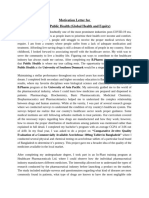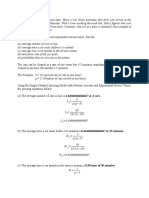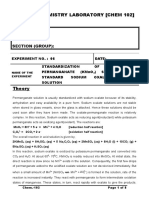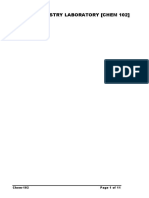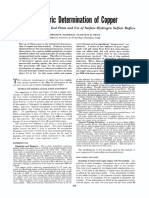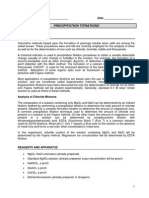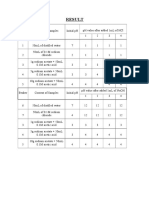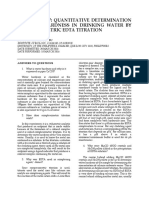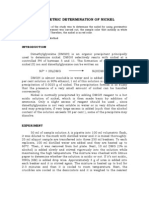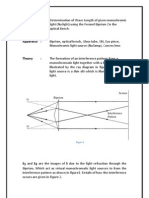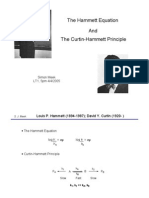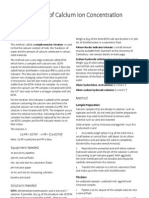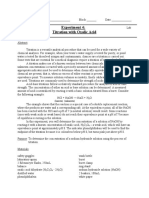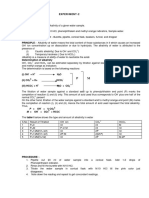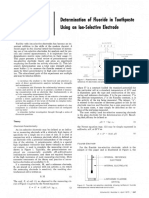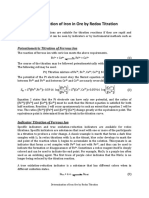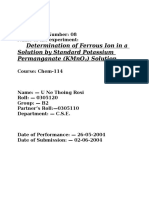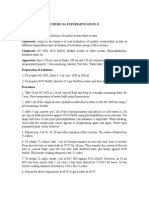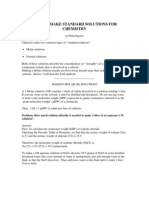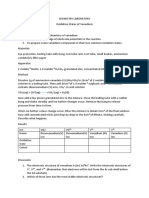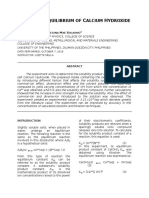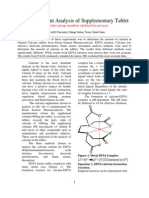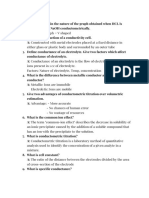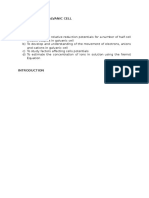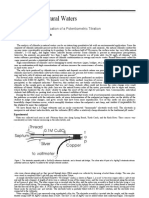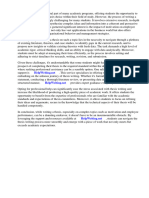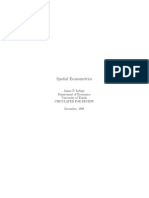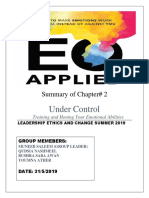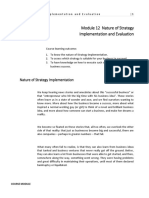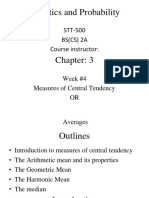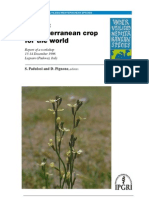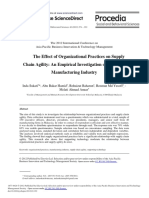Copper Determination in Water by Standard Addition Potentiometry
Copper Determination in Water by Standard Addition Potentiometry
Uploaded by
Aura Ballesteros MontealegreCopyright:
Available Formats
Copper Determination in Water by Standard Addition Potentiometry
Copper Determination in Water by Standard Addition Potentiometry
Uploaded by
Aura Ballesteros MontealegreCopyright
Available Formats
Share this document
Did you find this document useful?
Is this content inappropriate?
Copyright:
Available Formats
Copper Determination in Water by Standard Addition Potentiometry
Copper Determination in Water by Standard Addition Potentiometry
Uploaded by
Aura Ballesteros MontealegreCopyright:
Available Formats
tion of a homogeneous solution, for then the concentration of AgCl should depend on the total amount of AgBr previously
formed. The data thus indicate that the activity of AgCl after TI is essentially constant. This is strong support for the validity of Equation 6 vis a vis Equation 3. The value of the slope is consistent with the data of Myer et al. I1 I ) who found that the chronopotentiometry of the
formation of AgCl upon silver electrodes is not reversible. Received for review May 16, 1972. Accepted December 15. 1972. This paper is based on a thesis submitted on May 15, 1966, by Arnold Hoffman to the Faculty of the Polytechnic Institute of Brooklyn in partial fulfillment of the requirements for the Ph.D. degree.
Copper Determination in Water by Standard Addition Potentiometry
Michael J. Smith and Stanley E. Manahan2
Department of Chemistry. Universiry of Missouri-Coiumbia. Coiumbia. Mo. 65207
Downloaded by UNIV NAC DE COLOMBIA UNAL on October 22, 2009 | http://pubs.acs.org Publication Date: May 1, 1973 | doi: 10.1021/ac60328a009
The determination of copper in water samples using standard addition techniques with an ion selective electrode is facilitated through the use of a complexing antioxidant buffer (CAB). With the method, copper in tap water has been determined at concentrations down to 9 pg/l. Copper at a level of 9.0 pg/l. added to natural water samples containing between 3.3 and 46.8 pg/l. was analyzed with an average per cent recovery of 102.9% and a relative standard deviation of 7.5%. Reagent purity is a major limiting factor in the analysis, and detailed directions are given for preparing the copper-free reagents required in the analysis.
We have found the solid-state cupric ion-selective electrode to be very useful in the investigation of the copper micronutrient requirement for algae. Since copper is a limiting nutrient for algae only below approximately 40 pg/l. in water, the study of copper deficiency places extreme demands upon the techniques used to remove copper from the nutrient media and requires highly sensitive analyis of the copper-deficient media. Potentiometry with the copper electrode offered the only satisfactory method for analyzing these low copper media and techniques were developed for the analysis of very low levels of copper. This paper describes these techniques as applied to the analysis of tap water and natural waters.
STANDARD ADDITION POTENTIOMETRY Direct potentiometry generally does not yield highly accurate results. Examination of the equation for the cupric ion-selective electrode response.
lent cation electrode potentials of k5 mV are common, particularly when the electrodes are placed in different solutions. Thus, direct potentiometric analysis requires very frequent restandardization. The achievement of optimum accuracy in the potentiometric determination of ion concentrations with ion-selective electrodes requires that the potential recorded in the unknown solution should be compared t o the potential measured in a standard solution having exactly the same medium, a t a concentration very close to that of the sought-for ion, and measured under identical conditions a t about the same time. Such conditions are approximated by a method variously known as standard addition, known increment, or spiking. Basically the method consists of measuring the potential of the electrode system in a relatively large, accurately measured volume of the sample solution, adding a known small volume of a relatively concentrated solution of the sought-for ion, and recording the potential after the addition of standard. The initial concentration may be calculated from the potential shift. The method assumes that the activity coefficient of the ion does not change and that the liquid junction potential remains constant. These are generally valid assumptions when relatively small concentration increments are involved. Furthermore, if the volume of standard solution added is relatively small, dilution may be ignored. The method also works with samples in which the analyte ion is complexed-so long as the fraction which is complexed does not change with the addition of standard. The calculations involved in standard addition are relatively simple. The potential, E l , of a copper electrode LS. a reference electrode in a sample solution may be given as, E l = E, S logCo 2)
where E is the measured potential, E , is a constant term, 2.303RT/2F is the Nernst slope, and acu2+ is the activity of the cupric ion shows that the measured potential is a function of the log of the ion activity. Thus relatively small errcrs in potential result in relatively large errors in ion activity (and concentration). In the case of a divalent ion electrode, an error of only 2 mV produces a relative concentration error of 16%. Day-to-day changes of diva1 Present address, Department of Chemistry. Wright State University, Dayton, Ohio 45431. 2 Author to whom inquiries should he addressed.
where Co is the concentration of copper in the sample, and S is the theoretical Nernst factor, 2.303RT/2F, or an experimentally determined value. The term E, contains a correction for the activity coefficient of cupric ion and, in some cases, for the fraction of cupric ion complexed. Both the activity coefficient and the fraction complexed must remain constant during the addition of standard copper for the method to be valid. If a known volume, V,, of a standard cupric ion solution of concentration C, is added to the initial volume, V,, of the sample, the new potential, E2, is given by the equation,
836
ANALYTICAL CHEMISTRY, VOL. 45, NO. 6, MAY 1973
which if Vsis much smaller than V , simplifies to
r
n 17 1
The shift in potential, E2 - El, is related to the original sample concentration by the following equation:
E? - E ,
S log
(5)
If the term, Z, is defined as
= antilog[-]
the following equation may be derived:
[z - 1 = - -C"V0 x v.]
cT
is)
Downloaded by UNIV NAC DE COLOMBIA UNAL on October 22, 2009 | http://pubs.acs.org Publication Date: May 1, 1973 | doi: 10.1021/ac60328a009
Equation 7 indicates that C, may be calculated from a single addition or preferably determined from the slope of a plot of 2 - 1 us. V, where several additions of standard are made.
COMPLEXING ANTIOXIDANT BUFFER In order to successfully measure cupric ion concentrations in tap water samples, a complexing antioxidant buffer (CAB) had to be added to the sample. The stock buffer solution consists of a mixture of 0.05M sodium acetate, 0.05M acetic acid, 2.0 x 10-2M sodium fluoride, and 2.0 X 10-3M formaldehyde and is used 1:l with the sample solution. It serves the following functions: adjusts pH, complexes cupric ion, complexes interfering ferric ion, regulates ionic strength, and provides a moderately reducing medium. The potentiometric measurement of copper requires a moderately acidic medium. In media having p H values above neutrality, the formation of insoluble cupric hydroxides, carbonates, and phosphates interferes with potentiometric measurements of cupric ion concentration. Appreciable formation of the hydroxy complex, CuOH+, occurs above p H 6, resulting in potential drift and errors in measured concentration. At very low p H values, the electrode does not function properly and gives erroneously high values of cupric ion concentration. The p H of an equimolar sodium acetate-acetic acid buffer (pH 4.8) is about optimum for the measurement of cupric ion concentration, and this system was chosen for p H adjustment. Acetate ion forms a complex with cupric ion, with a formation constant of 106.3 for the 1:l complex ( I ) . The presence of complexing acetate ion in the buffer serves to decomplex copper from all but very strong complexing agents and prevents removal of copper from solution by precipitation and sorption on container walls. Since the acetate is added in a large excess, a constant fraction of the copper is present in the form of Cuz+ ion, which is one of the criteria for the successful use of standard addition. Based on the relative solubilities of copper(I1) sulfide and iron(II1) sulfide, it may be expected that ferric ion a t a concentration greater than approximately 0.1 x [Cu2+] interferes with the electrode response. Frequently water samples contain iron(I1) which is converted t o iron(II1) by air oxidation. At p H values above approximately 4, the iron(II1) precipitates from solution as the hydrated iron(111) oxide. This cannot be tolerated in copper-containing samples because of coprecipitation of copper(I1). We have observed a loss of copper of around 90% over a 24-hour period because of coprecipitation with hydrated iron(II1)
(1) E Gellesand R M Hay.J Chem SOC 1958,3673 3684 3689
oxide. Rapid precipitation of iron(II1) can be prevented by complexing the iron(II1) with fluoride ion. Therefore, fluoride was added to the CAB buffer. The attainment of stable potentials required the presence of a mild reducing agent and formaldehyde was used. The action of the reducing agent is not, fully explained. It is known, however, that oxidizing agents such as ferric ion interfere with the copper electrode. Severe electrode instability was noted when low level Cu2+ measurements were attempted in the presence of oxidizing agents. Since the operation of the copper electrode involves an equilibrium between Cu2+ and S2- (21, it is possible that the interference results from the oxidation of intermediate sulfide a t the electrode surface. The rapid oxidation of S2-by Fe3+ even a t very low concentrations is a well known reaction (3). In addition to formaldehyde, hydroxylamine hydrochloride and ascorbic acid were tried as antioxidants, but both materials reduced even low levels of cu2+. The use of ascorbic acid as an antioxidant in low level potentiometric sulfide measurements is well established ( 4 ) . The use of antioxidants has not been reported previously, however, in connection with low level cupric ion measurements made in the presence of iron(II1) and other oxidizing agents.
EXPERIMENTAL
The copper electrode used was a n Orion Model 94-29A solidstate cupric ion electrode referred to a n Orion Model 90-02,double junction reference electrode. A solution of 10% K N 0 3 was used in the outer chamber of the reference electrode. Potentials were measured t o 0.1 mV with a n Orion Model 801 digital p H meter and recorded with a Texas Instruments Servoriter-I1 recorde:. The use of a recorder was necessary to discern the slow potential drift that occurs as the cupric ion electrode equilibrates in samples containing very low levels of copper. The solutions were contained in a jacketed glass cell and maintained a t a temperature of 25.00 f 0.05 "C by means of water circulating through the cell jacket. A small amount of methylene blue chloride was added to the circulating water to eliminate the slight response of the cupric electrode to ambient light fluctuations. The cell shown in Figure 1 was useful for samples of 50 to 100 ml in volume. A Teflon (DuPont) cover was fitted to the cell to prevent contamination and aid in temperature control. A special feature of the apparatus which was extremely helpful in achieving stable potentials is the spiral-shaped glass stirrer driven at 260 rpm. Much less potential fluctuation was observed than when a magnetic stirrer is used. The glassware used in this study was cleaned with a 3 : l ( v : v ) mixture of concentrated HzS04 and "03. The mixture was a satisfactory substitute for chromic acid cleaning solution. Between runs the cell, electrodes, and glassware were rinsed with a solution of 1.0 x 10-3M NazEDTA followed by thorough rinsing with deionized distilled water. Standard copper solutions prepared by diluting a stock 3000 mg/l. copper sulfate solution were added to the cell with a Hamilton 50-pl gas-tight syringe equipped with a Chaney adapter and a pipet delivery needle. The complexing antioxidant buffer (CAB) solution, 0.100M in total acetate plus acetic acid, and having a p H of 5.0,'was prepared by mixing 100.0 ml of 1.00N Aristar acetic acid (GallardSchlesinger Chemical Mfg. Corp.), 63.5 ml of 1.00N ultrapure KOH (Alfa Inorganics), 0.84 gram of ultrapure N a F (Alfa Inorganics), and 2.0 ml of 1.OM formaldehyde solution (Matheson, Coleman and Bell). The resulting mixture was diluted to 1 liter. Buffer solutions prepared as described are typically 1 p g / l . in copper. The use of the ultrapure reagents is imperative to prevent contamination of the buffer with copper. Procedure. T a p water samples were analyzed directly from the tap, and natural water samples were first filtered through a 0.45( 2 ) Richard A. Durst. "Ion-Selective Electrodes," Nat. Bur. Stand. I U . S . I Spec. Pub/ 314, 1969.
(3) M . J.
Sienko and R. A . Plane, "Chemistry," 2nd ed., McGraw-Hill
Book Company, Inc., New York. N. Y . , 1961, p 523. (4) News/ett.!Specific / o n Electrode Techno/.. 3 ( 5 and 6) (1971). ANALYTICAL CHEMISTRY, VOL. 45, NO. 6, M A Y 1973
837
10 cm
Em
cm
Downloaded by UNIV NAC DE COLOMBIA UNAL on October 22, 2009 | http://pubs.acs.org Publication Date: May 1, 1973 | doi: 10.1021/ac60328a009
5 cm
Figure 1. Jacketed glass cell used for cupric ion measurements
p membrane filter. A 50.0-ml portion of sample and 50.0 ml of CAB were added to the cell and the potential was allowed to equilibrate. The initial electrode potential and the potentials after each of 3 additions of standard Cu2+ were recorded. The concentration and volume of the standard Cu2+ solution were chosen such that the initial change in potential for the first addition of standard corresponded to an approximate doubling of the initial copper concentration. At the 30 pg/l. level, ca 20 minutes are required for the initial electrode equilibration. Equilibration times between additions a t this level are typically 10 minutes. Initial electrode equilibration times varied from less than one minute at 1 mg/l. Cu to as long as one hour a t arnund 1 pg/l. P u . A recorder trace for the multiple addition analyses of 9.0 and 900 pg/l. samples is given in Figure 2. A plot of 2 - 1 GS V, was prepared and the concentration of copper in the diluted sample was determined from the slope of the resulting linear plot. A typical plot is shown in Figure 3. Because of dilution, the original sample concentration is twice the value determined from the plot. Standard addition potentiometric determination of copper requires a linear electrode response and a knowledge of the slope of a plot of E us. the log of copper concentration, normally 2.3RT/ 2F. Furthermore, the level of copper contamination in the reagents used for the analysis should be known. All of these parameters may be determined by means of an addition-calibration step. The potential of the electrode system is measured in a mixture consisting of equal quantities of high purity deionized water and buffer or equal quantities of sample and buffer. Next a single standard addition is made such that the electrode potential shifts positive ca 9 mV corresponding to an approximate doubling of the copper concentration. With the same solution, a calibration
*
v
180
! 170
E k
H
160
pc, =
9.0 pgll cu
C , = 900 pg/l Cu
c, =
V,
3000 mg/i cu
= 100.00 m l = 30.0 pi
v,
3 H d
1
I
I I
s wi
$1
. 120
110
0.2
0.4
0.6
0.8 1.0 1.2 ELAPSED TIME (HRS.)
1.4
1.6
1.8
2.0
Figure 2. Recorder trace for multiple addition analysis of copper with tne solid-state copper electrode
1.6
cSTD =
30.00 mg/l
Cu
1.2
curve of E cs. log of copper concentration was prepared through a series of additions of standard comer solution 100 times more concentrated than the solution used for the single addition step. Thus, the copper present after the first single addition is insignificant in Concentration compared to the large excess used for the calibration. Although the slope of electrode response is determined at a much higher copper concentration than that of the contaminant copper, it is possible to calculate the concentration of contaminant copper and plot it on the calibration curve. If the point thus obtained falls on the calibration plot, the electrode response is linear down to the contaminant level, whereas, if it does not, the response is nonlinear and the calculated value of contaminant copper is not valid. This approach is particularly valuable in t h a t it gives the background copper level and validates the slope of the electrode response in the actual medium where
1.
a38
ANALYTICAL CHEMISTRY, VOL. 45, NO. 6 , MAY 1973
Table I. Composition of Tap Water Analyzeda
Concentration, Component
Table Ill. Recovery Study for Known Amounts of Cu Added to Filtered Natural Water Samples in CAB Solution
Sample
No.
msll.
59.2 27.2 46.5 5.6 90'0 357.4 0.3 Cu found in Sample, Fg/l. 16.3 32.6 46.8 36.4 3.3 16.3 Cu added,
@g/l.
Ca2+
Mg2+
Na+ K+
so42-
Theoretical Fg/I. Cu after addition of spike 25.3 41.6 55.8 45.4 12.3 25.3
Cu found in spike,
Fg/l,
Recovery of spike, % 113.3 97.8 110.0 102.2 93.3 101.1 102.9 7.5
1 2
HC03NOSCOS*CI -
3
4
0.0
32.9 1.2 0.02 <0.1 8.0
5
6
9.0 9.0 9.0 9.0 9.0 9.0
10.2 8.8 9.9 9.2 8.4 9.1
F-
Fe
AI Si02
Average % recovery: Standard deviation:
Mn Zn
p H = 7.2
-0
1
c
v
a Source: Department of Public Health and Welfare of Missouri, Division of Health, Environmental Services Laboratory.
Downloaded by UNIV NAC DE COLOMBIA UNAL on October 22, 2009 | http://pubs.acs.org Publication Date: May 1, 1973 | doi: 10.1021/ac60328a009
Table 11. Results for Triplicate Analysis of Cu Spiked 0.050M CAB Solution by Multiple Addition at Varying Levels of Cu( I I) a
Sample
No.
Cu spike,
FSII.
Av Cu found,
FSil.
SLOPE
= 29.7 rnV
Total Cu found, pg/l. 1 2 3 8.5 8.0 10.2 1 9.0 2 27.0 26.2 28.0 25.9 94.2 92.6 86.2 3 90.0 901. 901. 4 900.0 901. a Corrected for 1.6 Fg/l. Cu contamination in CAB.
8.9 26.7 91 .o 901.
' 1 '
'
'
0.0
0.b
C.8
1.2
1.5 2.0 LOG [CU(II)]
2.4
2.8
background level. The value of the slope calculated by leastsquares analysis is 29.7 mV w i t h a standard error of estimate of 0.2 mV.
Figure 4. Addition-calibration plot for the determination of background copper and electrode response in 1 : 1 CAB buffer-water
RESULTS AND DISCUSSION
A number of different kinds of samples were analyzed by standard addition. The level of copper contamination in the CAE3 buffer solution was checked by multiple standard addition. Three analyses of the CAB buffer gave copper levels of 1.15, 1.32, and 1.21 pg/l. ' Tap water from Columbia, Mo., was analyzed by multiple standard addition, yielding a value of 36.4 pg/l. of copper, which agrees well with the value of 40 pg/l. of copper commonly found in this water supply. The linearit y of the multiple addition plot indicates that the copper was in a nonchelated form, or that the buffer system was effective in decomplexing the copper from any ligands which might be present. The composition of the sample matrix is given in Table I. Water samples from a number of sources were analyzed using the multiple addition technique and no difficulties were encountered. There exists a possibility of precipitating CaF2 from hard waters having extremely high levels of Ca2+ when the F--containing CAB solution and sample are mixed. In such samples, precipitation of CaF2 can be prevented by reducing the concentration of fluoride in the buffer. The loss of copper from untreated water samples upon standing is illustrated very well by the analysis of tap water samples. Copper losses of up to 90% for untreated water samples stored overnight in polyethylene bottles were observed. Typically, an untreated tap water sample
went from 36.4 pg/l. copper to 3.3 pg/1. copper upon standing for 17 hours. In order to ensure that copper could be successfully determined a t varying levels and in order to estimate the precision with which copper measurements could be made in CAB solution, triplicate analyses of copper-spiked 0.050M CAB were run. The values of copper concentration obtained were corrected for contaminant copper in the CAB buffer. Copper spikes of 9.0, 27.0, 90.0, and 900 pg/l. were prepared. The results of the analysis are given in Table 11. One of the more realistic ways of evaluating this technique is the recovery of known amounts of copper from natural water samples. Recovery was investigated with tap water samples containing from 3.3 to 46.8 pg/l. of copper initially. The recovery data for 6 samples spiked with 9.0 pg/l. of copper are given in Table 111. The average per cent recovery is 102.9% with a standard deviation of 7.5%. Received for review September 14, 1972. Accepted December 14, 1972. This research was supported by the United States Department of the Interior Office of Water Resources Research Allotment Grant A-049-MO and the University of Missouri Environmental Trace Substances Center. M.J.S. acknowledges financial support from an NSF Student Originated Studies Grant GY-9186 and from an NDEA Title IV Graduate Fellowship.
ANALYTICAL C H E M I S T R Y , VOL. 45, NO. 6, M A Y 1973
839
You might also like
- Motivation Letter For MSC in Public Health (Global Health and Equity)Document2 pagesMotivation Letter For MSC in Public Health (Global Health and Equity)Avi shekNo ratings yet
- Full Report Exer 1Document8 pagesFull Report Exer 1marinella100% (1)
- Activities For Finals Building and Enhancing LiteraciesDocument20 pagesActivities For Finals Building and Enhancing LiteraciesDemzDanmer Zann Paulite Cerdeña75% (12)
- Going Bad: Icp-Oes Analysis of Metals in Apples: Kaitlyn MchughDocument13 pagesGoing Bad: Icp-Oes Analysis of Metals in Apples: Kaitlyn MchughKaitlyn McHughNo ratings yet
- Harry's Car Wash - Queuing TheoryDocument3 pagesHarry's Car Wash - Queuing TheoryestoniloannNo ratings yet
- Experiment 3 Redox Titration Percent Purity AnalysisDocument5 pagesExperiment 3 Redox Titration Percent Purity AnalysisnanaNo ratings yet
- Lab Report Acid BaseDocument4 pagesLab Report Acid Basexuni34No ratings yet
- Gravimetric Determination of Moisture CoDocument5 pagesGravimetric Determination of Moisture CoDEFIN BIMA REYNANDANo ratings yet
- Gravimetry Lab Report Experiment 01Document4 pagesGravimetry Lab Report Experiment 01PDPPPMAT0621 Ruhilin Binti NasserNo ratings yet
- Chemical Kinetics: The Iodine Clock Reaction: J. CortezDocument6 pagesChemical Kinetics: The Iodine Clock Reaction: J. CortezKyle CortezNo ratings yet
- Employee Engagement CIPDDocument29 pagesEmployee Engagement CIPDejazsuleman50% (2)
- Post-Laboratory Report Experiment 2: Potential of A Galvanic CellDocument5 pagesPost-Laboratory Report Experiment 2: Potential of A Galvanic CellerizaNo ratings yet
- LAB GravimetricAnalysisSulfateMixtureDocument3 pagesLAB GravimetricAnalysisSulfateMixtureDNo ratings yet
- Exp 6 (Solved) 1Document8 pagesExp 6 (Solved) 1mahmudulNo ratings yet
- Exp 7 (Solved)Document9 pagesExp 7 (Solved)mahmudul100% (1)
- Exp 8 (Solved)Document11 pagesExp 8 (Solved)mahmudulNo ratings yet
- The Fluoride Ion Selective Electrode ExperimentDocument5 pagesThe Fluoride Ion Selective Electrode Experimentlisaaliyo0% (1)
- Chem Lab Manual 0910Document52 pagesChem Lab Manual 0910Namrata BajpaiNo ratings yet
- Laboratory Report of Melting PointDocument5 pagesLaboratory Report of Melting PointHanna Anne88% (8)
- Copper IodometricDocument6 pagesCopper IodometricSyam abbas100% (1)
- Iodimetric Titration: Aim: PrincipleDocument2 pagesIodimetric Titration: Aim: PrincipleHarsh ThakurNo ratings yet
- Argento Me TryDocument5 pagesArgento Me TryGino GalanoNo ratings yet
- Determination of The Solubility Product Constant of Calcium Hydroxide Chem 17Document7 pagesDetermination of The Solubility Product Constant of Calcium Hydroxide Chem 17Frances Abegail QuezonNo ratings yet
- DiscussionDocument3 pagesDiscussionSiti HajarNo ratings yet
- Experiment 7 AtqDocument13 pagesExperiment 7 AtqBea Francesca SosaNo ratings yet
- CHEM 334L - Conductance of Solutions - Estimating K For A Weak AcidDocument4 pagesCHEM 334L - Conductance of Solutions - Estimating K For A Weak Acidfdobonat613100% (1)
- Determination of Trace Sulfur Method With Non-Dispersive Gas PDFDocument4 pagesDetermination of Trace Sulfur Method With Non-Dispersive Gas PDFRuben Perez AyoNo ratings yet
- Ion-Selective Electrode Determination of Fluoride Ion: Chemistry 321L ManualDocument5 pagesIon-Selective Electrode Determination of Fluoride Ion: Chemistry 321L Manuallsueyin100% (1)
- Chem 26.1 DataDocument2 pagesChem 26.1 Datagamingonly_accountNo ratings yet
- Experiment 4 CHM421Document9 pagesExperiment 4 CHM421Abg Khairul Hannan Bin Abg AbdillahNo ratings yet
- Lab Manual Metal Acetylacetonate Complexes Web PDFDocument22 pagesLab Manual Metal Acetylacetonate Complexes Web PDFYan Jie ChongNo ratings yet
- Titrimetric Methods of Analysis 2Document30 pagesTitrimetric Methods of Analysis 2Isnehaya BangcolaNo ratings yet
- Lab Repot Analytical 1Document2 pagesLab Repot Analytical 1yangkmjNo ratings yet
- Interference PatternsDocument8 pagesInterference PatternsAsa mathewNo ratings yet
- Chem 113 - Water Sample Lab ReportDocument16 pagesChem 113 - Water Sample Lab Reportapi-356033847No ratings yet
- Cinetica Reaccion FeCl3 Con KIDocument8 pagesCinetica Reaccion FeCl3 Con KIAngie RiobambaNo ratings yet
- Hammett Plots2Document42 pagesHammett Plots2Sankar SasmalNo ratings yet
- CalciumDocument3 pagesCalciumMuhammad Amir AkhtarNo ratings yet
- AN5391 Determination of TKN in Water by Using KT8000 SeriesDocument7 pagesAN5391 Determination of TKN in Water by Using KT8000 SeriesJaysonAbenirCabahug100% (1)
- Chm312 AasDocument9 pagesChm312 Aassarah qistina100% (1)
- Fluoride Ion Selective ElectrodeDocument14 pagesFluoride Ion Selective ElectrodeMihEugen100% (1)
- Lab ReportDocument9 pagesLab ReportmawarNo ratings yet
- Experiment 4: Titration With Oxalic Acid: (Known) (Unknown)Document4 pagesExperiment 4: Titration With Oxalic Acid: (Known) (Unknown)Aditya SinghNo ratings yet
- Lab Experiment 3 Ka Determination Through PH TitrationDocument4 pagesLab Experiment 3 Ka Determination Through PH TitrationxmusiqaNo ratings yet
- Experiment2 18052012Document3 pagesExperiment2 18052012Abhishek Shetty100% (1)
- ADSORPTIONDocument6 pagesADSORPTIONSatyamGupta0% (1)
- CHE 331 Past Term Paper AnswersDocument5 pagesCHE 331 Past Term Paper AnswersKatlo KoketsoNo ratings yet
- Determination of Fluoride in Toothpaste Using An Ion-Selective ElectrodeDocument4 pagesDetermination of Fluoride in Toothpaste Using An Ion-Selective ElectrodevaninorNo ratings yet
- Determination of Iron in Ore by Redox TitrationDocument5 pagesDetermination of Iron in Ore by Redox TitrationVinayakNo ratings yet
- Cis Trans Isomerism Maleic AcidDocument5 pagesCis Trans Isomerism Maleic Acidsachin0002No ratings yet
- VinegarDocument14 pagesVinegarLynn HeimatotoNo ratings yet
- Determination of Ferrous Ion in A Solution by Standard Potassium Permanganate (Kmno) SolutionDocument3 pagesDetermination of Ferrous Ion in A Solution by Standard Potassium Permanganate (Kmno) SolutionTowfiq Hossain TaskuNo ratings yet
- Making Molar & Normal SolutionsDocument10 pagesMaking Molar & Normal SolutionsAbhijit GadheNo ratings yet
- Determination of Fluoride Ion Using An Ion Selective ElectrodeDocument4 pagesDetermination of Fluoride Ion Using An Ion Selective ElectrodeHuyentrang Nguyen100% (1)
- Kinetics of Ester Hydrolysis NewDocument3 pagesKinetics of Ester Hydrolysis Newbits_who_am_iNo ratings yet
- FR PDFDocument4 pagesFR PDFGoku SanNo ratings yet
- Making Molar & Normal SolutionsDocument10 pagesMaking Molar & Normal Solutionsammuluhai333100% (2)
- Oxidation State of VanadiumDocument2 pagesOxidation State of VanadiumLeeanaNo ratings yet
- S E C H: Olubility Quilibrium of Alcium YdroxideDocument6 pagesS E C H: Olubility Quilibrium of Alcium YdroxideGiselle ReyesNo ratings yet
- New ReportDocument6 pagesNew Reportapi-212407625No ratings yet
- Quiz QsDocument6 pagesQuiz QsaruukadlabalNo ratings yet
- Experiment 1Document6 pagesExperiment 1Rusni RusliNo ratings yet
- Chloride in Natural Waters: An Environmental Application of A Potentiometric TitrationDocument3 pagesChloride in Natural Waters: An Environmental Application of A Potentiometric TitrationJhefer Avila OlorteguiNo ratings yet
- Pumps, Channels and Transporters: Methods of Functional AnalysisFrom EverandPumps, Channels and Transporters: Methods of Functional AnalysisNo ratings yet
- Curriculum 04112024171500Document4 pagesCurriculum 04112024171500Snahil patelNo ratings yet
- Assessment of Canteen and It's Practices Celestino ThesisDocument47 pagesAssessment of Canteen and It's Practices Celestino ThesisTRISTANE ERIC SUMANDENo ratings yet
- Tariq Javed Education HSR 2017 Mohi Ud Din Islamic Univ AJK 23.11.2017 PDFDocument409 pagesTariq Javed Education HSR 2017 Mohi Ud Din Islamic Univ AJK 23.11.2017 PDFSara YounusNo ratings yet
- Thesis On Motivation and Employee Performance PDFDocument7 pagesThesis On Motivation and Employee Performance PDFtracywilliamssalem100% (2)
- Training and DevelopmentDocument33 pagesTraining and DevelopmentmsbdNo ratings yet
- Spatial EconometricsDocument284 pagesSpatial EconometricscerdenkNo ratings yet
- ImpactofE CommerceonBusinessPerformanceDocument9 pagesImpactofE CommerceonBusinessPerformanceOlvinaNo ratings yet
- PEGS CatalogDocument88 pagesPEGS CatalogMNo ratings yet
- Chap#2 Summary Applied EqDocument4 pagesChap#2 Summary Applied EqHina HussainNo ratings yet
- Selection Testing - PpsDocument15 pagesSelection Testing - PpsNawab RajpootNo ratings yet
- Factsheet M21Document8 pagesFactsheet M21TANASEGMIHAINo ratings yet
- W12 & W13 Nature of Strategy Implementation and Strategy Evaluation - ModuleDocument18 pagesW12 & W13 Nature of Strategy Implementation and Strategy Evaluation - ModuleShaila AmorNo ratings yet
- Interlanguage Pragmatics and Second Language Acquisition Gabriele Kasper - University of Hawai ... (PDFDrive)Document15 pagesInterlanguage Pragmatics and Second Language Acquisition Gabriele Kasper - University of Hawai ... (PDFDrive)devyNo ratings yet
- Julia Leung Curriculum VitaeDocument3 pagesJulia Leung Curriculum Vitaeapi-535645606No ratings yet
- Organizational Behavior Hawthorne Studies & Its Critical AnalysisDocument4 pagesOrganizational Behavior Hawthorne Studies & Its Critical AnalysisAnjum AfzalNo ratings yet
- Statistics and Probability: STT-500 BS (CS) 2A Course InstructorDocument27 pagesStatistics and Probability: STT-500 BS (CS) 2A Course InstructorMuhammad AliNo ratings yet
- OHSAS 18001 ChecklistDocument12 pagesOHSAS 18001 ChecklistSyed Ibrahim100% (1)
- Ba ZG524 Course HandoutDocument9 pagesBa ZG524 Course HandoutsravanthiNo ratings yet
- SM II CombinedDocument146 pagesSM II Combinedashutosh nibmNo ratings yet
- CPDDocument5 pagesCPDqwertyNo ratings yet
- Data Quality and Data Cleaning: An OverviewDocument27 pagesData Quality and Data Cleaning: An OverviewSohaibNasirNo ratings yet
- Risk-Based Pipeline Integrity Management CourseDocument3 pagesRisk-Based Pipeline Integrity Management Coursemah_abdelaal100% (1)
- Rucula A Mediterranean Crop For The WorldDocument101 pagesRucula A Mediterranean Crop For The WorldAldo A Guerrero CNo ratings yet
- Thinking Responsibly About Responsible AI and The Dark Side of AIDocument13 pagesThinking Responsibly About Responsible AI and The Dark Side of AIGeetika JainNo ratings yet
- Skinner 2007Document30 pagesSkinner 2007InêsNo ratings yet
- SC Practices AgilityDocument8 pagesSC Practices AgilityKavitha Reddy GurrralaNo ratings yet
